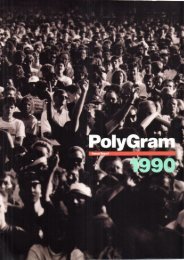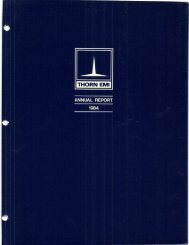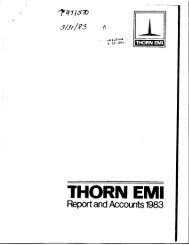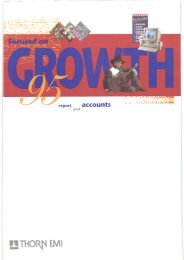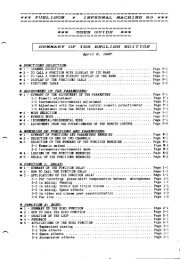Untitled - David Kronemyer
Untitled - David Kronemyer
Untitled - David Kronemyer
Create successful ePaper yourself
Turn your PDF publications into a flip-book with our unique Google optimized e-Paper software.
DEPRECIATION oF TANGIBLE FIXED ASSETS Depreciation of property, plant" equipment<br />
and vehicles is calculatcd on cost at rates estimated to write off the cost oI the relevant<br />
assets by equal annual amounts over their expeaed uselul lives; eflect is given, where<br />
necessary" to commercial and technical obsolescence.<br />
Rental equipment is depreciated to a nil residual value, by the application ol basic<br />
depreciation rates, on a graduated basis, liom the month of installation, so that a relatively<br />
high charge is borne in the early years.<br />
The annual rates used are:<br />
Freehold buildings and long leasehold prope*y, 20lo<br />
Short leasehold property, over period of lease,<br />
Plant, equipment and vehicles, at rates ranging liom 100/o tr-r 33%0/0.<br />
Rental equipment; the periods used are:<br />
Colour sets, 6 years (overseas, other than Australia and New Zealand, 5 years),<br />
Video equipment, 4 years,<br />
Monochrome sets, I year.<br />
LEASING Tangible fixed assets acquired under finance leases are not capitalised. Rentals<br />
payable under both linance and operating leases are written off as incurred.<br />
REoRcANISATION CosTS The costs of business reorganisation are provided when a<br />
reorganisation decision has been made in principle. Costs relating to the reorganisation of<br />
continuing businesses are chargcd against profit before taxation and those relating to<br />
withdrawal lrom businesses, or their lundamental restructure, are charged as<br />
extraordinary items.<br />
STOCKS and work in progress are stated at the lower of cost and net realisable value, less<br />
progress payments on uncompleted contracts and provisions lbr expected losses. Cost<br />
includes manulacturing overheads where appropriate. A consewatively estimated profit<br />
elcmcnt is taLen during the course of long-term conbacts.<br />
The inclusion of attributable prolit in long-term conhact work in progress is in<br />
accordance u,ith Statement of Standard Accounting Practice No. 9.'l'his constitutes a<br />
departure liom the statutory valuation rules, but is required by S22B(2) ol the Companies<br />
Act 1985 to enable the accounts to give a true and lair view. As progre66 pa)'ments cannot<br />
meaninglully be allocated between cost and prolit, it is impracticable to deterrnine the<br />
effect of the departure on the value ol the long-term contract work in progress shown in<br />
the balance sheet.<br />
TAXATION lhe Company has undertaken to discharge the liability to corporation tax of<br />
the majority of wholly-owned UK subsidiaries. Their IJK tax liabilities are, therefore, dealt<br />
*it-h in th" a,. ounto ol the Companl.<br />
Delerred taxation is calculated using the liability method in respect of timing<br />
dillerences arising primarily lrom the dillerent accounting and tax treatment of<br />
depreciation. Provision is made, or recovery anticipated, where timing dillerences are<br />
cxpected to reverse in the lbreseeable luture.<br />
WARR{NTY PROVISIONS Many products carry formal guarantees of satislactory<br />
performance lbr varying periods fbllowing purchase by customers, Provision is made lbr<br />
the estimated cost of honouring unexpired warranties.<br />
RESEARCH AND DEVELOPMENT erpenditure is wdtten oll as incur:red.





